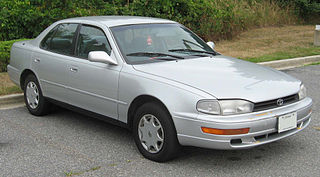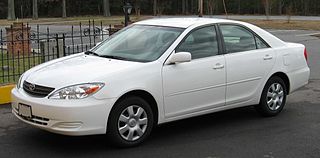
A van is a type of road vehicle used for transporting goods or people. Depending on the type of van, it can be bigger or smaller than a pickup truck and SUV, and bigger than a common car. There is some variation in the scope of the word across the different English-speaking countries. The smallest vans, microvans, are used for transporting either goods or people in tiny quantities. Mini MPVs, compact MPVs, and MPVs are all small vans usually used for transporting people in small quantities. Larger vans with passenger seats are used for institutional purposes, such as transporting students. Larger vans with only front seats are often used for business purposes, to carry goods and equipment. Specially equipped vans are used by television stations as mobile studios. Postal services and courier companies use large step vans to deliver packages.

The Toyota Celica is an automobile produced by Toyota from 1970 until 2006. The Celica name derives from the Latin word coelica meaning heavenly or celestial. In Japan, the Celica was exclusive to the Toyota Corolla Store dealer chain. Produced across seven generations, the Celica was powered by various four-cylinder engines, and bodystyles included convertibles, liftbacks, coupés and notchback coupés.

The Chevrolet Impala is a full-size car that was built by Chevrolet for model years 1958 to 1985, 1994 to 1996, and 2000 to 2020. The Impala was Chevrolet's popular flagship passenger car and was among the better-selling American-made automobiles in the United States.

The Chevrolet Corvair is a compact car manufactured by Chevrolet for model years 1960–1969 in two generations. A response to the Volkswagen Beetle, it remains the only American-designed, mass-produced passenger car with a rear-mounted, air-cooled engine. The Corvair was manufactured and marketed in 4-door sedan, 2-door coupe, convertible, 4-door station wagon, passenger van, commercial van, and pickup truck body styles in its first generation (1960–1964) and as a 2-door coupe, convertible or 4-door hardtop in its second (1965–1969) – with a total production of approximately 1.8 million from 1960 until 1969.

The Honda Accord, also known as the Honda Inspire in Japan and China for certain generations, is a series of automobiles manufactured by Honda since 1976, best known for its four-door sedan variant, which has been one of the best-selling cars in the United States since 1989. The Accord nameplate has been applied to a variety of vehicles worldwide, including coupes, station wagons, hatchbacks and a Honda Crosstour crossover.

The Cadillac Eldorado is a luxury car manufactured and marketed by Cadillac from 1952 until 2002 over twelve generations.

The Lincoln Continental is a series of mid-sized and full-sized luxury cars produced between 1939 and 2020 by Lincoln, a division of the American automaker Ford Motor Company. The model line was introduced following the construction of a personal vehicle for Edsel Ford, who commissioned a coachbuilt 1939 Lincoln-Zephyr convertible, developed as a vacation vehicle to attract potential Lincoln buyers. In what would give the model line its name, the exterior was given European "continental" styling elements, including a rear-mounted spare tire.

The Mazda MX-6 is a front-engine, front-wheel-drive coupé manufactured and marketed by Mazda from 1987 to 1997 across two generations.

The Honda CR-X del Sol is a two-seater targa-top car manufactured by Honda from 1992 until 1998. Despite the body resemblance to a mid-engine car design, the del Sol is based on the front-engined Honda Civic platform and was the successor to the Honda CR-X.

The Ford Tempo is a compact car that was produced by Ford from the 1984 to 1994 model years. The replacement for the Ford Fairmont, the Tempo marked the first use of front-wheel drive by Ford outside of the subcompact segment. Along with transitioning to front-wheel drive, the Tempo marked significant downsizing over its predecessor. Mercury marketed the model line under the Mercury Topaz nameplate. The model line was produced as a two-door coupe and a four-door sedan through its production.

The Buick Roadmaster is an automobile that was built by Buick from 1936 until 1942, from 1946 until 1958, and then again from 1991 until 1996. Roadmasters produced between 1936 and 1958 were built on Buick's longest non-limousine wheelbase and shared their basic structure with the entry-level Cadillac Series 65, the Buick Limited, and after 1940, the Oldsmobile 98. Between 1946 and 1957 the Roadmaster served as Buick's flagship.

The Chrysler PT Cruiser is a compact car that was built by the American company Chrysler from 2001 until 2010. Introduced as a five-door hatchback wagon, a two-door convertible variant was also made from 2005 to 2008.

The Toyota 4Runner is an SUV manufactured by the Japanese automaker Toyota and marketed globally since 1984, across five generations. In Japan, it was marketed as the Toyota Hilux Surf and was withdrawn from the market in 2009. The original 4Runner was a compact SUV and little more than a Toyota Hilux pickup truck with a fiberglass shell over the bed, but the model has since undergone significant independent development into a cross between a compact and a mid-size SUV. All 4Runners have been built in Japan at Toyota's plant in Tahara, Aichi, or at the Hino Motors plant in Hamura.

The Lotus Excel is a sports car designed and built by British automobile manufacturer Lotus Cars from 1982 to 1992. It is based on the design of the earlier Lotus Eclat, which itself was based on the earlier Lotus Type 75 Elite.

The Cadillac Series 70 is a full-size V8-powered series of cars that were produced by Cadillac from the 1930s to the 1980s. It replaced the 1935 355E as the company's mainstream car just as the much less expensive Series 60 was introduced. The Series 72 and 67 were similar to the Series 75 but the 72 and 67 were produced on a slightly shorter and longer wheelbase respectively. The Series 72 was only produced in 1940 and the Series 67 was only produced in 1941 and 1942. For much of the postwar era, it was the top-of-the-line Cadillac, and was Cadillac's factory-built limousine offering.

The Toyota Camry (XV10) is a mid-size car that was produced by Toyota between 1991 and 1996 in Japan and North America, and 1993 and 1997 in Australia. The XV10 series represented the third generation of the Toyota Camry in all markets outside Japan, which followed a different generational lineage. The XV10 Camry range is split into different model codes indicative of the engine. Four-cylinder models use the SXV10/SDV10 codes, with VCV10 designating the six-cylinder versions, and MCV10 the later six-cylinder cars in North America only.

The Ford Crown Victoria Police Interceptor is a four-door, body-on-frame sedan that was manufactured by Ford from 1992 to 2011. It is the police car version of the Ford Crown Victoria and was the first vehicle to use the Ford Police Interceptor name.

Subaru launched the third generation Japanese and world-market Legacy in June 1998, while the North American model was introduced in May 1999 for the 2000 model year. In all markets except for the United States, production lasted through 2002, with a limited production Blitzen model sold mid-cycle under the 2003 model year in Japan. Production in the United States lasted through 2004.

The Toyota Camry (XV30) is a mid-size car produced by Toyota from June 2001 to January 2006. The XV30 series represented the fifth generation of the Toyota Camry in all markets outside Japan, which followed a different generational lineage. The XV30 range is split into different model codes indicative of the engine. Four-cylinder models utilize the ACV30 and ACV35 codes, with MCV30 (3.0-liter) and MCV31 (3.3-liter) designating the six-cylinder versions.
The sixth-generation Honda Accord was available as a four-door sedan, a two-door coupe, five-door hatch and station wagon and was produced by Honda from September 1997 until 2002 and from 1998 to 2003 in Europe.



















